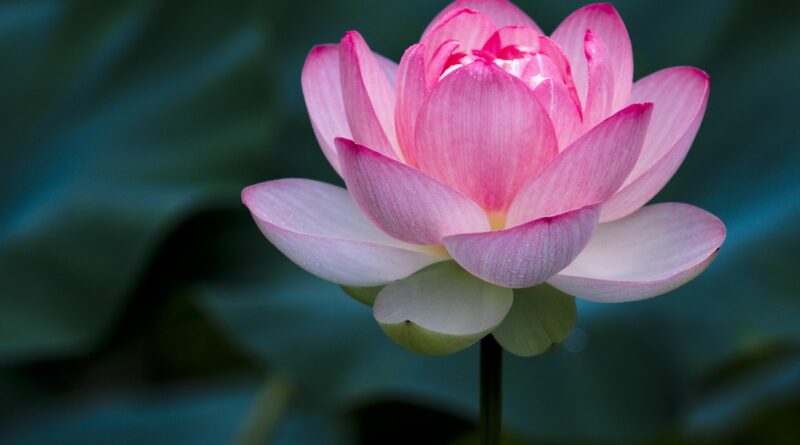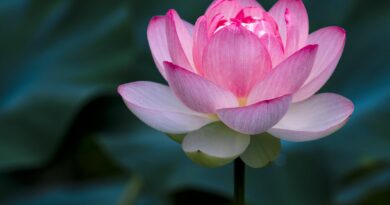A Conglomeration Of Germs
A Conglomeration of Germs
July 18, 2018
I don’t know if you’ve ever contemplated our hummingbirds. They’re living in a very unnatural situation here. Hundreds of them have a couple of feeders they share. That’s not how they usually live in nature. Out in nature, each hummingbird has its own territory, which is quite large because it needs lots of flowers to survive. Yet here they’re living in close quarters, and for the most part they get along. But then little squabbles break out here and there, and sometimes everything collapses. One hummingbird decides it’s going to take over a particular feeder and chases everybody else away. Or they get angry at one another for some reason, and things begin to break down. This morning the nectar ran out in almost all the feeders, and they began to get unglued.
You can compare all this to the body. Think of the body as being composed of lots of little one-celled organisms that have learned to get along, but every now and then, things begin to fall apart. Fights break out. Some of them may turn on a particular part of the organism with an autoimmune disease. Sometimes a few of them decide to keep growing and growing and growing, and the others can’t stop them. That’s how the body develops cancer.
So it’s pretty amazing that the body works, because each little cell in there is programmed to behave sometimes in a social way and sometimes in an antisocial way. It’s good to think about the body like this so that we don’t get heedless.
That’s a lot of what the body contemplation is for: to counteract our heedlessness. To begin with, we have to remind ourselves that the body’s not all that attractive when you really look inside. When we think about what we eat, we usually think about food as what goes into the mouth, but what the organism is actually feeding off is the stuff down in the stomach and intestines, which is in a different condition entirely. Then there are all the things coming out of the body that we have to clean away, clean away, clean away. This is what we’ve got, and yet we’re so protective of it, because we need it to find happiness in life—at least that’s our attitude. In some ways that’s right; in some ways it’s wrong.
We need the body to practice, but for a lot of us the body has very little to do with practicing the Dhamma, and everything to do with practicing things that are not Dhamma. This is why we have to contemplate it to ask ourselves, “What in here is of any essence?” It’s all going to die someday.
If you’re attached to it, then when you die you’re not going to go anywhere. You’re just going to hang around. When Ajaan Fuang was teaching in Bangkok, he taught at a monastery that had a crematorium and sixteen of what he called “body shops”: the pavilions where they’d set out coffins and hold funerals.
Occasionally, say, on a Saturday evening when not too many people came to see him—most of the people on Saturdays would come in the middle of the day—if it was a Saturday evening, he might just walk around the monastery to stretch his legs. One evening he came back from his walk and said, “You know, the number of people who die and don’t leave their bodies is huge.” They’re so attached to them that even when they die, they still can’t go anywhere because this is all they know.
That’s one of the reasons why we practice developing some detachment toward the body: so that when the time comes to leave, we can leave neatly and move on to something better.
And of course, even as we’re alive there are lots of dangers in getting attached to the body in the wrong way. If we think that the value of the body lies in whether it’s attractive or not, that can create a lot of problems. If you are attractive in line with what society has decided is attractive, then you get really possessive of the body. There can be a lot of pride, but of a very unstable kind—because, after all, the body does age.
People who are proud of their appearance have to be constantly reassured that, yes, they’re still good-looking. While they’re still young, they’re constantly afraid of people who want to take advantage of their good appearance, and yet they also need other people to be attracted to them. I remember hearing of a French actor who once said that the easiest women to seduce are the ones who are pretty. The hardest ones are the ones who are not pretty. The ones who are not pretty say, “You’re being ridiculous.” The ones who are pretty are all too eager to go along—which is a weakness of character.
On the other hand, if you’re not attractive in line with society’s ideas, you can get really down on yourself. This is why we have that contemplation of the body to remind ourselves that the things that are unattractive in the body are unattractive in everybody. That’s what you can call a healthy negative body image.
But the contemplation of the body doesn’t end there. The body does have its good side, in that we can use it to practice. To sit here and meditate, you’ve got to have a body sitting. To give things, you need a body to do the giving. So, the body does have its uses, and you want to take care of it in the proper way.
Someone once came to see Ajaan Lee, complaining that some of his friends had found out that he was a meditator, and they said, “So, you say your body is not-self, then how come we can’t hit it?” He didn’t know how to answer. Ajaan Lee said to tell them, “It’s borrowed goods. I have to take care of it. I have to return it to the owner in good condition.” Well, “good condition” doesn’t mean attractive. It means good enough so that you can practice. So, you do take care of the body to that extent, but you have to contemplate again and again and again, to make sure that you’re not attached to the body any more than that.
Just realize that this is a pile of borrowed goods. All these little cells here are like a big conglomeration of germs that you’ve managed to latch on to. As the Buddha said, “See this as old kamma.” When you were born with this, this was the result of your old kamma. Now it’s the raw material with which you create new kamma, which is something you want to focus on because kamma is what really belongs to you. That’s what goes with you when you go, and that’s what shapes your mind as you stay here. As the Buddha said, the things you do again and again and again bend the mind in a certain direction. So try to bend it in a good direction.
Learn how to have the right attitude toward the body, that it’s a tool, something you’ve borrowed, a weird conglomerate of all these little germs: this flock of hummingbirds that sometimes gets along well and sometimes doesn’t. While it’s getting along well, try to make good use of it.
Even arahants take good care of their bodies. As long as they see that continuing to live in the human realm serves a purpose, they look after the body for that purpose. In this way, they give us a good example. They don’t need the body to gain awakening, because they’ve already gained awakening. But for those of us who have yet to gain any awakening, this is what we’ve got to use, so use it for that purpose.
And watch out for any tendencies of the mind to want to see the value of the body in some other way. Contemplate it so that you can have the right attitude toward it.
This contemplation is also good for seeing the power of perception.
In Thailand, sometimes the monks will go into hospitals. Over there they can actually make arrangements for monks to go in and see autopsies. One monk I knew noticed once, as he was going to see an autopsy, that in the office of the guys who were cutting up the corpses, there was a girly calendar. As if to reaffirm that, yes, there are some bodies that are good-looking—even though they were cutting up dead bodies day after day. That just goes to show the huge walls the mind can create for itself. If it wants to see something as attractive, it’ll do everything it can, regardless of the evidence all around it. And you can see this in yourself. You can do body contemplation and see all the aspects of the body that are strange or weird or incongruous, and then very quickly the mind can shift around and find the body attractive again.
So watch for the shift. This is the point where contemplation of the body gives rise to real insight into the power of perception—and the power of intention behind the perception. Again, what is that intention? It’s kamma. Where does that kamma come from? You want to look into it, because that, too, is your possession. If you’re not careful, that particular kind of kamma will lead you to come back again, looking for another weird conglomerate like this to keep the process going.
The body is not the problem. The problem is in the mind: in the intentions that drive the perceptions. We use the body as a tool to understand the mind, to train the mind. So, you look after it as you would look after any tool. But at the same time, you have to realize that, as with any tool, you can use it well or you can use it destructively. If you use it in a way that gives rise to more greed, aversion, and delusion, that’s destructive. If you use it in a way that gives rise to kamma that harms others, that’s destructive, too. If you use it to meditate—to give rise to concentration, to give rise to discernment—or as a means for generosity and virtue, that’s a sign that you really know how to use your body.
Take advantage of this conglomerate of old kamma that you’ve got, and while you can hold it together, learn how to use it well.



